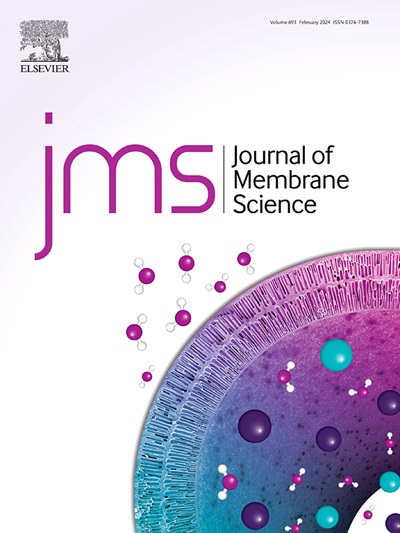Influences of substrate properties and liposome integration on high-flux thin-film composite desalination membranes
IF 9
1区 工程技术
Q1 ENGINEERING, CHEMICAL
引用次数: 0
Abstract
Most studies on biomimetic membranes for desalination have primarily focused on enhancing membrane performance, while the synergetic effects between substrate properties and biomimetic or nanomaterials remain underexplored. Herein, we propose a study to explore how the combination of substrate properties and synthetic liposomes can produce a high-performance hollow fiber reverse osmosis (RO) membrane. Hollow fiber polyethersulfone substrates with three different pore sizes (i.e. 6.0 nm, 8.5 nm and 10.0 nm) and varying porosities were used to study their effects on the selective layer formation and the membrane performance with and without 1,2-dioleoyl-3-trimethylammonium-propane (DOTAP) vesicle integration. The results revealed that substrate with moderate pore size (8.5 nm) and porosity worked best due to adequate reactive monomers availability and optimal heat dissipation during the interfacial polymerization (IP) reaction. On the contrary, DOTAP vesicles, which served to expand the miscible zone between two phases, at the same time slowing down MPD diffusion, facilitated the further growth of multilayered polyamide film. This multilayered selective layer morphology, characterized by significantly enlarged nanovoids size and increased surface roughness, enhanced the water transport pathways and effective filtration area, thereby contributing to the improved water permeability. Meanwhile, substrate optimization and liposome incorporation endued the RO membrane with a lower molecular weight cut-off and a narrower pore size distribution, both of which contributed to the enhancement of salt rejection performance. Therefore, compared to the DOTAP-free membrane with unoptimized substrate, the RO membrane with optimized substrate properties and liposome integration achieved an increased water permeability from 0.48 to 8.30 L m−2 h−1 bar−1, along with an improved salt rejection from 82.8 % to 94.5 % under low pressure condition (2 bar). This work highlights the importance of achieving a synergetic balance between substrate properties and nanomaterial additives to optimize the intricate IP process, thereby advancing the development of practical and scalable membranes for brackish water desalination, as demonstrated by the desirable long-term separation performance and reliable chemical cleaning tests.

底物性质及脂质体整合对高通量薄膜复合海水淡化膜的影响
大多数用于海水淡化的仿生膜的研究主要集中在提高膜的性能上,而基质性能与仿生或纳米材料之间的协同效应尚未得到充分的探讨。在此,我们提出了一项研究,探索如何结合底物特性和合成脂质体来生产高性能中空纤维反渗透(RO)膜。采用孔径分别为6.0 nm、8.5 nm和10.0 nm的中空纤维聚醚砜为基片,研究了不同孔隙率下的聚醚砜纤维基片在有1,2-二酰-3-三甲基丙烷(DOTAP)囊泡整合和不整合时对膜的选择性成层和膜性能的影响。结果表明,中等孔径(8.5 nm)和孔隙率的底物在界面聚合(IP)反应中具有良好的反应单体可用性和最佳的散热性能。相反,DOTAP囊泡扩大了两相之间的混相区,同时减缓了MPD的扩散,促进了多层聚酰胺膜的进一步生长。这种多层选择性层形态的特点是纳米孔隙尺寸显著增大,表面粗糙度增加,增强了水的输送途径和有效过滤面积,从而有助于提高透水性。同时,底物优化和脂质体掺入使反渗透膜具有更低的截分子量和更窄的孔径分布,从而提高了反渗透膜的防盐性能。因此,与未优化底物的无dotap膜相比,具有优化底物性能和脂质体整合的反渗透膜的透水性从0.48 L m−2 h−1 bar−1提高到8.30 L m−2 h−1 bar−1,同时在低压条件下(2 bar),盐的去除率从82.8%提高到94.5%。这项工作强调了在基材性能和纳米材料添加剂之间实现协同平衡的重要性,以优化复杂的IP过程,从而推进用于微咸水淡化的实用和可扩展膜的开发,正如理想的长期分离性能和可靠的化学清洗测试所证明的那样。
本文章由计算机程序翻译,如有差异,请以英文原文为准。
求助全文
约1分钟内获得全文
求助全文
来源期刊

Journal of Membrane Science
工程技术-高分子科学
CiteScore
17.10
自引率
17.90%
发文量
1031
审稿时长
2.5 months
期刊介绍:
The Journal of Membrane Science is a publication that focuses on membrane systems and is aimed at academic and industrial chemists, chemical engineers, materials scientists, and membranologists. It publishes original research and reviews on various aspects of membrane transport, membrane formation/structure, fouling, module/process design, and processes/applications. The journal primarily focuses on the structure, function, and performance of non-biological membranes but also includes papers that relate to biological membranes. The Journal of Membrane Science publishes Full Text Papers, State-of-the-Art Reviews, Letters to the Editor, and Perspectives.
 求助内容:
求助内容: 应助结果提醒方式:
应助结果提醒方式:


